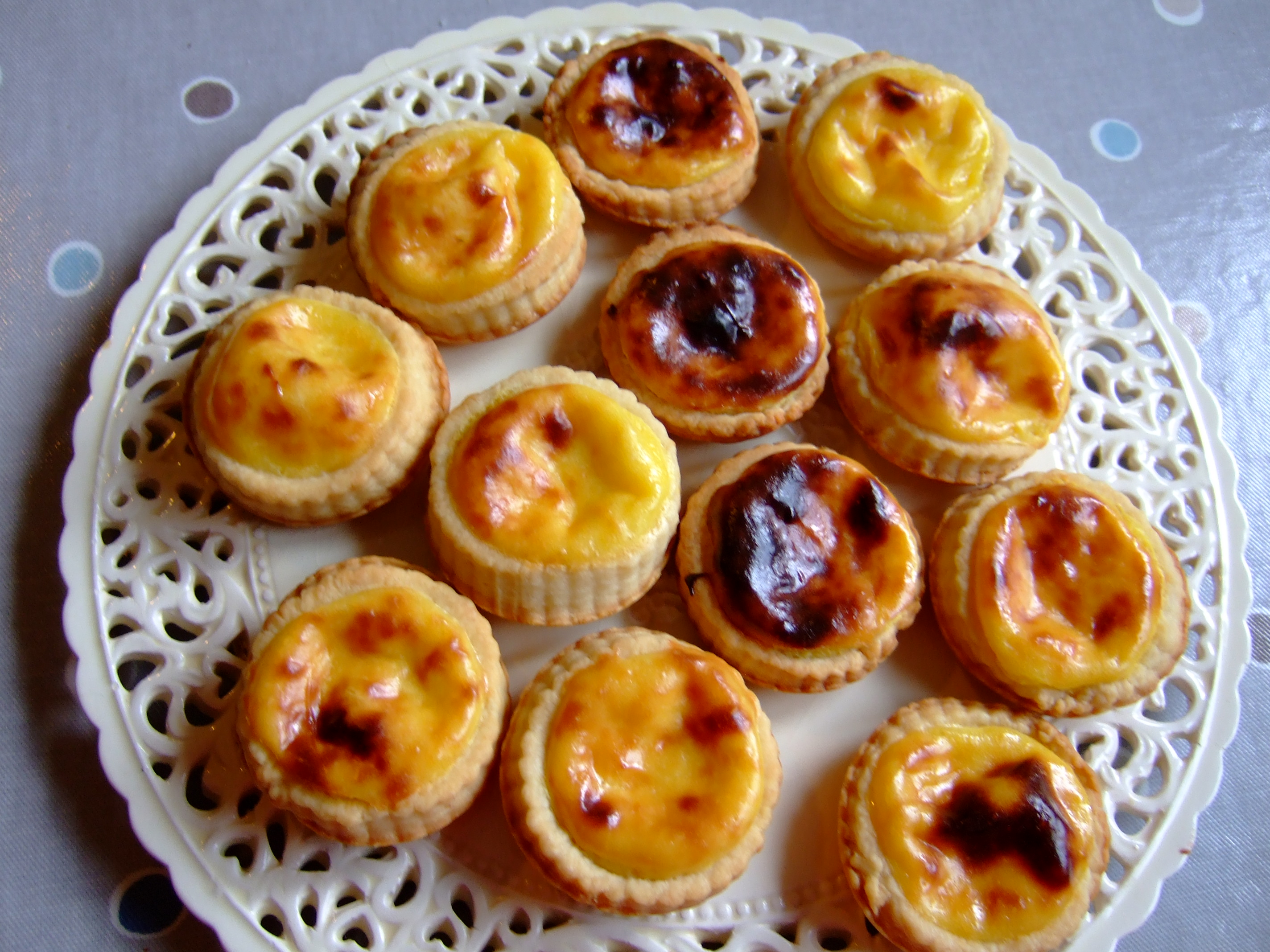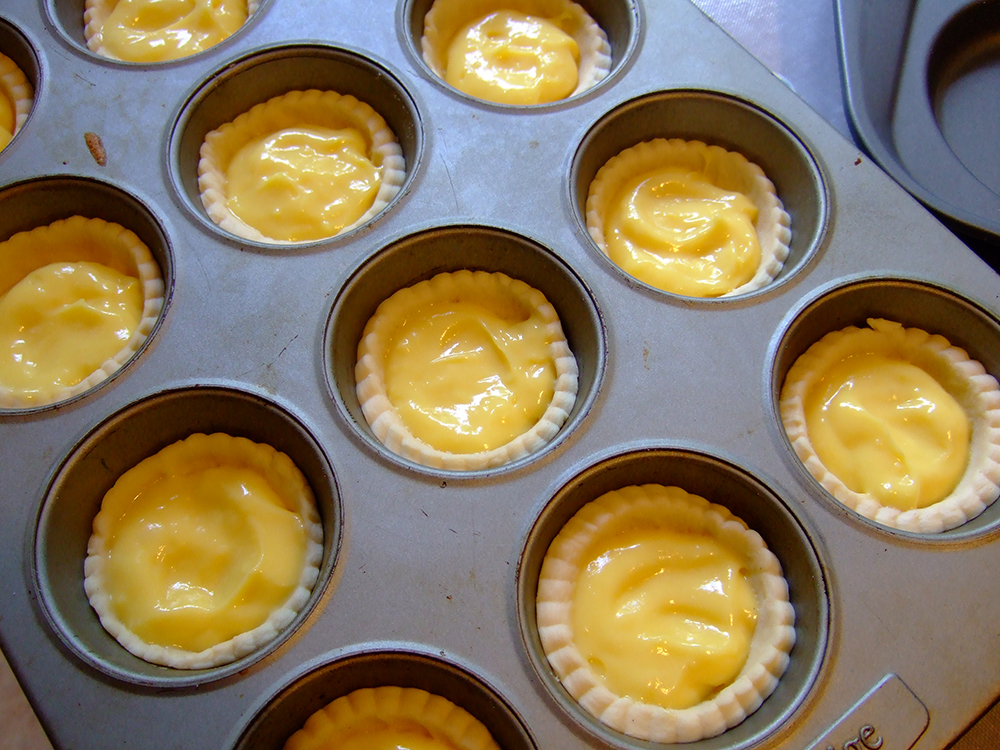I am, unsurprisingly, a fan of the Great British Bake Off. Watching the contestants make custard tarts a few weeks back coupled with a need for redemption for my poor custard quality on the Great Irish Bake Off, made me lust after a nice custard tart. These are lovely tarts with a flaky case and the cinnamony vanilla sweetness of the custard. They probably aren’t true to ‘Pasteis de nata’ but are tasty nonetheless.
I have made these tarts in a few different ways and have certainly factored in a few shortcuts that may horrify some people. On the other hand, the prospect of talking about shortcuts in a recipe where I suggest making a version of puff pastry, may horrify others. I enjoy making pastry but don’t really enjoy individually lining 12 mini tart tins to blind bake them. So I guess it’s all about what compromises you want to make, what parts of baking you enjoy and how much time you have!
I won’t judge you if you buy puff pastry, but will implore, beg and plead with you to try making it at least once. You don’t spend very long working with the pastry, most of the time the fridge is doing all the work for you. For this recipe, the custard needs to be completely cool so make it first, or even prepare the pastry and the custard the night before you need them.
I made these recently for an afternoon in The Moat Club, for a ‘Wilde about Afternoon Tea’ event, and they were the perfect accompaniment to an excellent and hilarious reading of The Importance of Being Ernest.
Custard Recipe
Ingredients
3 egg yolks
75 grams caster sugar
300 mls milk
A cinnamon stick
½ Vanilla pod or teaspoon of vanilla essence/paste
2 tablespoons of cornflour
Method
- Put the milk in a saucepan. Add the cinnamon stick and the half pod of vanilla with seeds scraped out (if using).
- Place over a low heat and bring slowly up the point where the milk around the edges of the saucepan have little bubbles and it is steaming. Do this slowly so that the milk has time to infuse with those lovely cinnamon and vanilla flavours.
- In the meantime, separate your eggs and place the yolks in a large bowl. Add the sugar, conflour and vanilla essence/paste if using.
- Mix them all together until well combined and the cornflour has no more lumps.
- Once the milk is hot enough, fish out the cinnamon stick and vanilla pod and pour it into the bowl and mix well. Pour it back into the saucepan.
Tip: Rinse off the cinnamon and vanilla pod when you fish them out. Let them dry (pop them into a warm oven for a few minutes). They can both be reused. It is particularly nice to store the vanilla pod in a jar of caster sugar so that you get lovely vanilla sugar.
- Turn the heat up to medium and mix using a wooden spoon. Keep scraping the bottom of the pan.
- Custard can curdle but this recipe has a generous amount of cornflour which helps protect against this. It will be a thicker custard than normal so any little thickened lumps of custard that you scrape up from the bottom will be easily beaten back into the mix.
- The custard will start to thicken. Once it starts to bubble, turn down the heat and cook for a couple of minutes for it to really thicken up, stirring all the time. Do not let it boil as it is likely to separate.
- Transfer into a bowl or jug and leave to cool. You can sieve it if you are concerned about lumps. Place cling film or parchment paper directly onto the surface of the custard to that a skin doesn’t form and let it cool completely.
Maybe while that is cooling you might try your hand at some speedy puff pastry?
Assembling and baking the custard tarts
This recipe makes 12 – 16 little tarts.
- Roll out the puff pastry really thin, to about 3 – 5 mm. It will puff up as it bakes and having it really thin means that you can get away without blind baking. You can roll it between parchment paper or on a floured surface.
- I used a standard muffin tin, so used a 9cm fluted cutter to line the cups. The pastry needs to come about half way up the sides.
- Puff pastry does not re-roll well because it disrupts all those lovely layers you worked to create, so cut the rounds as closely as possible together to minimise waste. (I normally mash the leftover bits together to make cooks samples!).
- Push the rounds into the tin and leave in the fridge to chill or about twenty minutes.
- Put the oven on to preheat to 220 degrees celcius.
- Put a generous teaspoon of the cold custard in each shell. Don’t overfill them as it will rise a bit.
- Pop in the oven for 12- 18 minutes. After ten minutes you move the trays around in the oven if they aren’t blistering evenly.
- These are custard tarts that are meant to be blistered and browned on top, rather like the topping of a rice pudding.
- Check the base is a lovely golden brown too.
- Let cool in the tins for five minutes before moving them to a cooling rack. The should slide out easily, but use a knife to loosen if any custard has over spilled and welded them to the tin.
These are delicious warm or cold.



Pingback: Speedy Puff Pastry « The Search For Delicious
Pingback: Clementine Shortcrust Pastry « The Search For Delicious